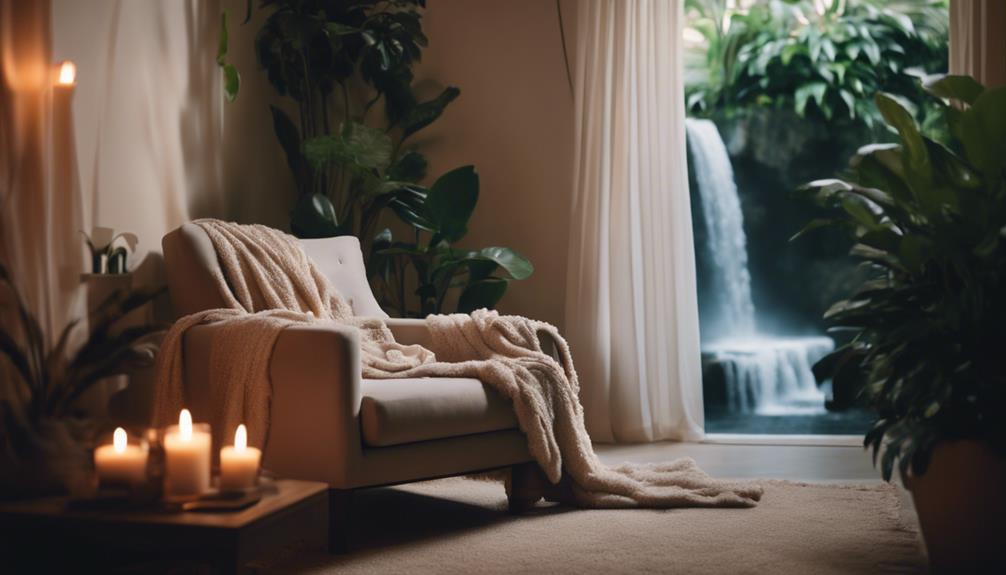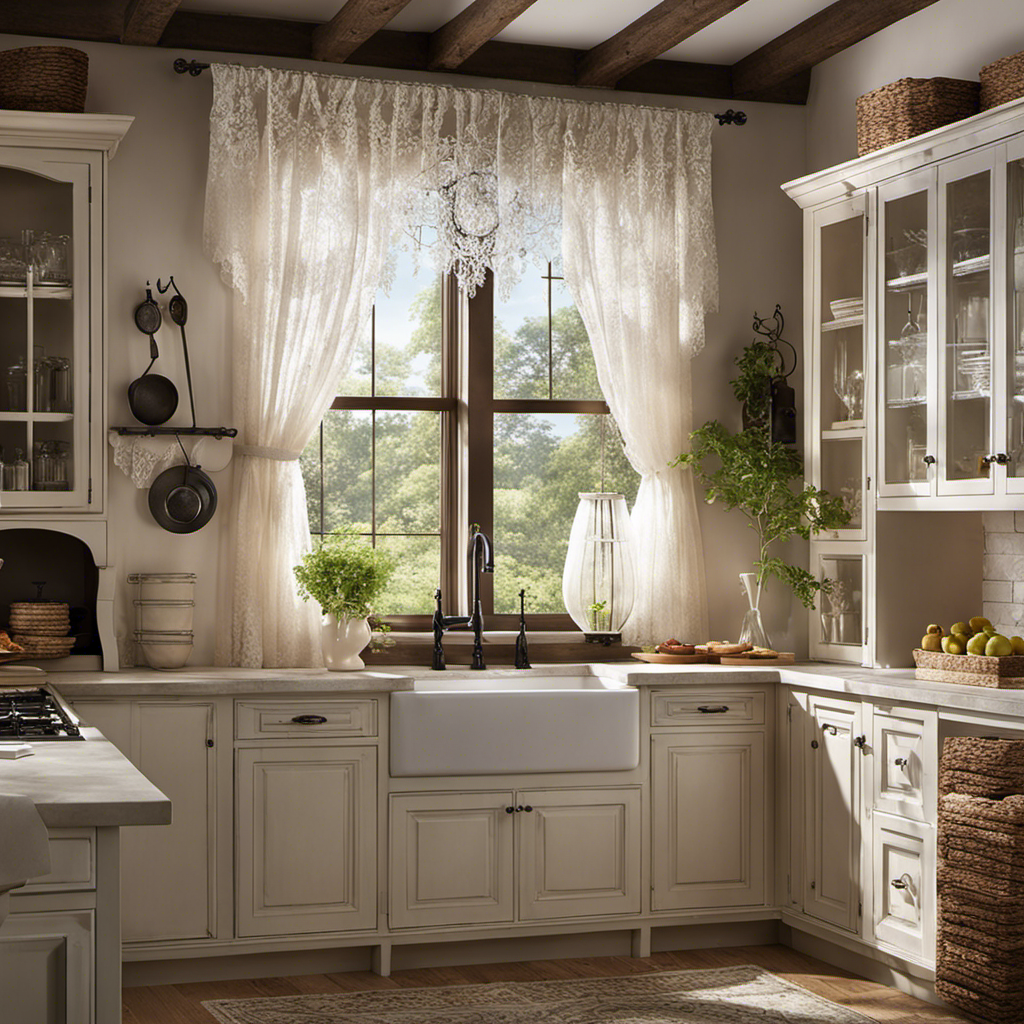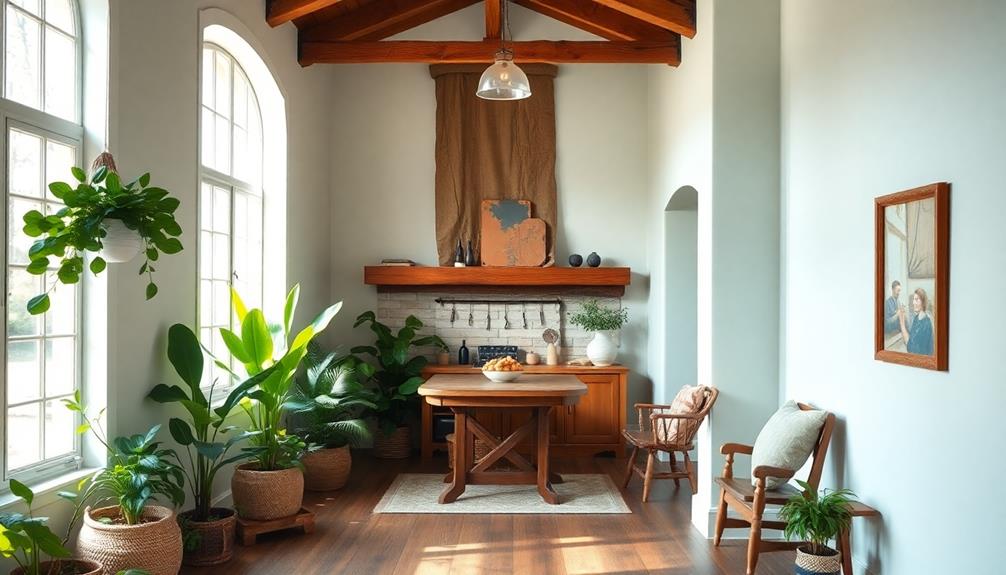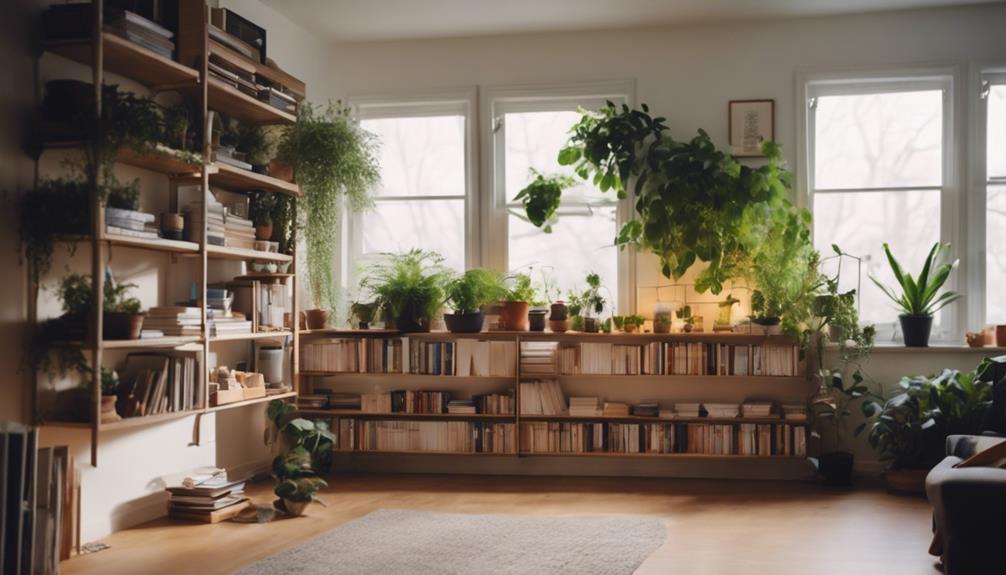Creating a relaxing sanctuary at home is essential for your mental well-being and can truly enhance your daily life. Start by selecting calming colors like soft blues and gentle greens to set a peaceful tone. Incorporate aromatherapy with scented candles or essential oil diffusers to uplift your mood. Indoor plants not only purify the air but also reduce stress. Personalize your space with cozy textiles and cherished items that reflect your identity. Establish relaxation areas filled with natural light and comfy seating. Finally, develop evening rituals to unwind each day. You'll discover even more transformative tips ahead!
Key Takeaways
- Choose calming colors like soft blues and gentle greens to create a tranquil atmosphere in your sanctuary.
- Incorporate aromatherapy with essential oils and scented candles to enhance mood and promote relaxation.
- Use indoor plants to reduce stress, purify air, and create a welcoming environment.
- Personalize your space with meaningful decor and cozy textiles to reflect your identity and foster emotional connection.
Importance of a Relaxing Home
A relaxing home is essential for your mental well-being, especially since many of us now blend work and personal life under one roof.
Creating a peaceful environment can profoundly impact how you feel at the end of the day. When you invest in a comfortable living space, you're not just making it visually appealing; you're actively working to reduce stress and enhance your mental health.
Incorporating calming routines into your daily life, like unwinding in a cozy corner with a good book or practicing mindfulness, can make a world of difference.
A tranquil home acts as a sanctuary where you can rejuvenate after a busy day. Regularly integrating self-care practices, such as creating a dedicated relaxation area, helps foster a sense of safety and emotional connection.
Selecting Calming Colors

Choosing calming colors can transform your space into a soothing retreat that promotes relaxation and peace. The right hues can create an environment that nurtures your well-being and fosters a sense of calm. Here are some color options to contemplate:
- Soft Blues: Mimic the sky and ocean, promoting tranquility.
- Gentle Greens: Evoke nature, enhancing health and connection to the outdoors.
- Neutral Tones: Beige and soft whites provide a versatile backdrop for vibrant accents while maintaining a serene atmosphere.
- Warm Yellows: Uplift your mood and add a cheerful touch, making your space feel inviting and cozy.
When selecting calming colors, remember to choose shades that resonate with you personally. This personal touch considerably enhances your comfort and emotional connection to your sanctuary.
Incorporating Aromatherapy and Candles

Incorporating aromatherapy and candles transforms your sanctuary into an oasis of tranquility, enhancing your relaxation experience with soothing scents. Scented candles not only create a warm ambiance, but they also positively affect your mood and reduce stress. Consider using essential oil diffusers for continuous aromatherapy benefits, especially with calming scents like lavender and eucalyptus. These scents can help alleviate anxiety and promote a sense of calm, making it easier for you to unwind.
Here's a quick guide to help you choose the right scents for your relaxing sanctuary:
| Scent | Benefits | Use Case |
|---|---|---|
| Lavender | Alleviates anxiety, promotes calm | Evening relaxation |
| Eucalyptus | Clears the mind, boosts focus | Morning energy boost |
| Citrus (Lemon) | Uplifting, enhances mood | Daytime refreshment |
| Sandalwood | Grounding, promotes meditation | Deep relaxation sessions |
Investing in high-quality scented candles and aromatherapy products can elevate your home environment, creating a spa-like atmosphere that enhances your self-care routine and overall well-being.
Benefits of Indoor Plants

Adding indoor plants to your space greatly enhances tranquility and improves your overall well-being. By integrating greenery into your home, you're not just beautifying your environment; you're also taking essential steps to create a sanctuary that nurtures your mental health.
Here are five powerful benefits of indoor plants:
- Reduced Stress: Studies reveal that indoor plants lower stress and anxiety levels, fostering a more peaceful atmosphere.
- Air Purification: Plants like peace lilies and snake plants filter toxins from the air, creating healthier breathing conditions.
- Mindfulness Practice: Caring for your plants promotes mindfulness, helping you stay present and connected.
- Increased Productivity: A natural environment boosts focus and productivity, making your home a more effective workspace.
With these benefits, it's clear that indoor plants are more than just decorative elements; they're essential companions in your journey toward a more serene and balanced life.
Embrace the power of nature, and watch your sanctuary flourish!
Personalizing Your Space

Creating a relaxing sanctuary goes beyond indoor plants; personalizing your space with meaningful decor and cherished items makes it truly reflect your identity and comfort. When you incorporate textures and fabrics that resonate with your style—like cozy throw blankets and plush pillows—you not only enhance the warmth of your environment but also create a cozy atmosphere that invites you to unwind.
Consider uplifting decor choices, such as family pictures or favorite artwork, to foster an emotional connection and promote relaxation. Soft lighting, like string lights, can transform your space into a tranquil retreat after a long day.
You can also establish dedicated areas for personal hobbies, ensuring every corner of your sanctuary caters to your interests. Here's a quick reference table to guide you in personalizing your space:
| Decor Element | Purpose | Tips |
|---|---|---|
| Family Photos | Enhance emotional connection | Use various sizes and frames |
| Cozy Textiles | Create a cozy environment | Mix and match textures |
| Soft Lighting | Promote relaxation | Opt for dimmable options |
Creating Functional Relaxation Areas

To truly relax, you need designated spaces that cater to your favorite activities.
Whether it's a cozy reading nook, a hobby zone for your crafts, or an outdoor retreat for quiet reflection, each area can enhance your sanctuary.
Let's explore how to create these functional relaxation zones in your home.
Designated Relaxation Spaces
Designating specific areas in your home for relaxation, like reading nooks or meditation corners, can greatly enhance your well-being and mindfulness. Creating designated relaxation spaces that promote relaxation involves careful planning and thoughtful choices. Here are some key elements to evaluate:
Natural Light: Position your relaxation areas near windows to soak up sunlight, boosting your mood and energy.
Comfortable Furnishings: Choose plush chairs or chaise lounges that invite you to unwind and support good posture.
Calming Colors: Opt for blues and greens on the walls or accents to evoke tranquility and peace.
Personal Touches: Incorporate cherished photographs, favorite books, or artwork that resonates with you, making the space uniquely yours.
Clutter-Free Environment: Keep these areas organized and free from distractions to enhance mental clarity and minimize stress.
Hobby Zones Creation
Establishing hobby zones in your home allows you to engage in your favorite activities while fostering relaxation and creativity. These functional spaces can make you feel more connected to your interests and enhance your overall well-being. Here's how to create a home that reflects your passions:
| Hobby Zone Type | Essential Elements |
|---|---|
| Reading Nook | Comfortable seating, good lighting |
| Crafting Space | Organized supplies, calming colors |
| Workout Zone | Clear space, natural light |
Make sure each hobby zone is equipped with comfortable seating, proper lighting, and necessary supplies. This encourages regular use and makes activities more enjoyable. Incorporate personal touches and calming colors to foster a sense of ownership. Regularly declutter these areas to maintain focus on relaxation and creativity, minimizing distractions.
Utilize natural light and views of nature to create an inviting environment that promotes mental clarity while you indulge in your interests. By setting up these hobby zones, you not only create a home that reflects your personality but also nurture your emotional well-being.
Outdoor Retreat Integration
Creating a serene outdoor retreat can transform small spaces into inviting areas for relaxation and connection with nature. By carefully designing your outdoor environment, you can create functional relaxation spots that help rejuvenate your mind and spirit. Here are some essential elements to keep in mind:
- Comfortable Seating: Hammocks or lounge chairs encourage you to unwind and soak in the beauty around you.
- Fire Pits or Dining Tables: These features foster intimate gatherings, allowing you to connect with loved ones while enjoying the outdoors.
- Outdoor Lighting: String lights or lanterns create a cozy atmosphere for evening relaxation and socializing.
- Greenery: Incorporate potted plants or small gardens to enhance air quality and promote a calming environment.
Establishing Relaxation Rituals

To truly unwind, you need to establish relaxation rituals that work for you.
Start by incorporating daily mindfulness practices and an evening wind-down routine to signal your body it's time to relax.
Don't forget to schedule weekly self-care activities that rejuvenate both your mind and spirit.
Daily Mindfulness Practices
Daily mindfulness practices, like meditation and deep breathing, can transform your routine into a soothing ritual that markedly reduces stress and anxiety. By setting aside just a few moments each day, you can take care of your mental well-being and promote relaxation in your life.
Here are some effective mindfulness practices to incorporate into your daily routine:
- Meditation: Spend 5-10 minutes focusing on your breath to clear your mind.
- Deep Breathing: Inhale deeply for four counts, hold for four, and exhale for four to calm your nervous system.
- Journaling: Write down your thoughts and feelings to gain emotional clarity and process your day.
- Mindful Movement: Engage in yoga or tai chi to connect with your body and release tension.
Evening Wind-Down Routine
Establishing an evening wind-down routine helps signal your body that it's time to relax, enhancing your sleep quality and overall well-being. You can promote relaxation with just a few small changes to your nightly habits. Start by setting aside dedicated time for calming activities like reading, gentle stretching, or meditation. These practices can lower stress levels and create a smooth shift to sleep.
Consider creating a tranquil atmosphere by utilizing soft, diffused lighting and soothing scents, such as lavender or chamomile, through candles or essential oil diffusers. A warm bath with Epsom salts and aromatherapy can also provide a spa-like experience, helping to alleviate tension and prepare your body for rest.
Additionally, make it a point to turn off electronic devices at least an hour before bed. This simple change can remarkably improve your sleep hygiene.
Weekly Self-Care Activities
Incorporating weekly self-care activities into your routine can considerably enhance your relaxation rituals and boost your overall well-being. By dedicating time to these activities, you create a personal place of rest that nurtures your mental and emotional health.
Consider these self-care activities to promote relaxation:
- Indulge in a cozy bath with Epsom salts and essential oils after a hectic week.
- Schedule a self-care day for yoga, meditation, or leisurely reading to recharge.
- Host a weekly movie or game night with loved ones to foster connection and joy.
- Engage in outdoor relaxation activities like picnics or gardening to benefit from nature's tranquility.
Enhancing Comfort and Coziness

To create a truly relaxing sanctuary, focus on layering soft textiles and investing in plush furnishings that invite you to unwind. Start by choosing comfortable seating options like armchairs or chaise lounges that encourage relaxation. These pieces not only provide a cozy spot to sink into but also enhance your overall comfort.
Next, layer in soft throw blankets, cushions, and pillows. This combination adds a touch of warmth and makes your space feel inviting, encouraging you to linger longer. Opt for natural materials such as cotton, linen, and wool, as they feel great against your skin and contribute to a warm atmosphere.
Arrange your seating to foster conversation and relaxation, ensuring it's conducive to enjoying quality time. Consider ergonomic designs in your furniture choices, which support your physical well-being and allow you to relax without discomfort during leisure activities.
Frequently Asked Questions
How to Create a Sanctuary for Yourself?
To create a sanctuary for yourself, find a quiet, well-lit space in your home. Use soothing colors, display meaningful items, add plants, and establish a self-care routine that brings you peace and comfort.
How to Make Your Room Your Sanctuary?
To make your room your sanctuary, choose calming colors, add cozy furnishings, and include indoor plants. Personalize with photos and create a dedicated space for mindfulness practices. These elements invite tranquility and comfort into your life.
How Do You Create a Peaceful Atmosphere?
Imagine your mind as a garden; plant calming colors like blue and green, let soft lights bloom, and nurture with soothing scents. Surround yourself with cherished memories, creating a peaceful atmosphere that invites tranquility.
What Is a Sanctuary in a House?
A sanctuary in your house is a personal haven where you can relax and recharge. It's designed to promote comfort and emotional well-being, helping you escape daily stress and connect with your inner peace.
Can These Tips for Creating a Relaxing Sanctuary Also Work for a Home Sanctuary?
Creating a relaxing sanctuary at home is all about setting the right atmosphere. By implementing simple tips for home sanctuary, such as using calming colors, incorporating soft lighting, and minimizing clutter, you can transform any space into a peaceful retreat. Whether it’s a bedroom or a living room, these tips can work wonders.
Conclusion
Incorporating these tips will transform your home into a tranquil retreat, like stepping into a cozy haven that feels straight out of a classic movie.
By selecting calming colors, adding soothing scents, and personalizing your space, you'll create an atmosphere that invites relaxation.
Establishing rituals and functional areas for unwinding will help you escape the chaos of everyday life.
So, go ahead and craft your ultimate relaxing sanctuary—you deserve it!










